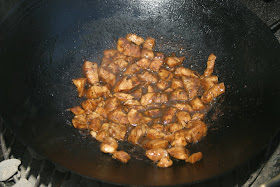
As much as I love beer, you’d think that I loved cooking with it as well. But generally, the only cooking with beer I ever do involves me cooking some food, and drinking said beer. Unlike wine, I’m just not a huge lover of the flavor of beer cooked into foods.
However, I recently discovered this recipe for beer brined pork chops, and I just had to try it out. I was pleasantly surprised by the results. The flavor of the dark oatmeal stout married quite well with the molasses, and gave a hint of sweetness to the chops.
Before we begin, a word on brining. These days, a pig is bred to be a very lean animal, and that means has substantially less flavor than it did 30-40 years ago. Brining remedies that to a certain extent. During the brining process, the salt is slowly absorbed in the pork, taking with it the other flavors as well. This can produce some very tasty pork.
Beer Brined Pork Chops
2 bone in pork chops, cut 1½ inches thick.
1 3/4 cups water
1 cup stout or other dark beer
2 tablespoons coarse salt
2 tablespoons molasses
2 teaspoons coarsely cracked black pepper
4 cloves garlic, minced
Trim fat from chops. As you can see in the above photo, we used chops with some of the loin, and some of the tenderloin–a sort of T-bone or porterhouse style pork chop. Place chops in a resealable plastic bag and place in a shallow dish. Combine water, stout, salt, molasses, and garlic. Here we've got a chance to show you another Pampered Chef gadget...the Garlic Press.
Just place a clove of garlic into it, press, and voila, minced garlic, and the skin is left behind. Simple.
When you've mixed everything, stir until salt dissolves. Pour stout over chops. Refrigerate for 8 to 24 hours.
The next day (yes, you gotta make this one in advance) drain chops, discarding brine. Pat chops dry with paper towel. Sprinkle pepper over each chop and rub in with your fingers.
Fire up your charcoal grill, and arrange medium hot coals for indrect grilling, with a drip pan in the middle. Here I've added a few chuncks of apple wood to partially smoke the chops as well.
Place the chops over the drip pan and close the grill. Ideally, you want to maintain about 300-350 in the grill, and the chops should take about 20-30 minutes.
Mmmmm. After about 20 minutes the chops are looking great, and taking on a nice color from the smoke. It's here that I'll give my spiel for a meat thermometer. If you're going to go to the trouble to cook a fine cut of meat like a steak or chop, why chance it. Take the guesswork out of the equation and get an instant read meat thermometer. That way, you can pull the meat off at the exact point of desired doneness, and not risk overcooking it.
That being said, I'll stay on my soap box a little longer. Most recipes call for cooking pork to 160 degrees, and while that may guarantee you a safe product, we find that pork done to this temp it way too dry. I pull my pork off of the grill when it reaches 135 degrees, and then let it rest for 10 minutes or so. It will continue to cook, and top out at 145-150, and be juicy and delicious, and perfectly safe too eat.
Okay, stepping off the soapbox now. Chops are done. So lets serve them, perhaps with some apple sauce, and that, a fine meal, will make.
Until next time,
Chris























+143.JPG)
+151.JPG)
+153.JPG)
+160.JPG)
+163.JPG)































